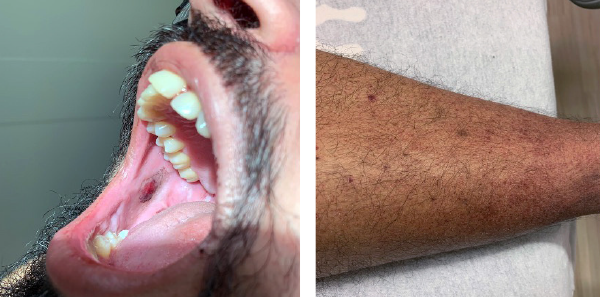
Living up to its former name, idiopathic thrombocytopenic purpura, the pathophysiology of what is now currently called immune thrombocytopenic purpura (ITP) remains somewhat enigmatic. A multitude of inciting factors have been identified, from infections and drugs to vaccinations and autoimmune conditions.1 Although most any vaccine can potentially trigger ITP, the alarming, emerging condition of vaccine-induced thrombotic thrombocytopenia (VITT) appears to have a specific link to the novel coronavirus (COVID-19) vaccines.2 While both clinical entities can present with signs and symptoms of thrombocytopenia, the pathophysiology and clinical management differ in significant ways. A predisposition to thrombosis, even in the setting of critical thrombocytopenia, distinguishes VITT from ITP and poses particular diagnostic and therapeutic challenges in the emergency department. In this article, a case of COVID-19 vaccine–induced ITP will be discussed in contrast with COVID-19 vaccine–induced VITT.
Explore This Issue
ACEP Now: Vol 40 – No 11 – November 2021The Case
A 34-year-old man with a past medical history of diabetes mellitus type II, hypertension, and hyperlipidemia presented to the emergency department for bleeding lesions in his mouth. The lesions began as painless, flat purple discolorations several days prior to his ED visit. They progressed in size and number, and when they began bleeding, he sought emergency care. He otherwise felt well. The patient reported that he had received his second dose of the Moderna COVID-19 vaccine one day prior to the lesions appearing and three days prior to presenting to the emergency department. He denied any adverse reactions to the first dose of vaccine or prior history of bleeding or easy bruising. Review of systems was negative for fevers, chills, weakness, fatigue, abdominal pain, hematemesis, dark tarry stools, or hematuria. He also denied any illicit drug abuse or history of alcoholism, cancer, and HIV. His initial vital signs were normal.
On physical exam, there were two hemorrhagic bullae in the buccal region of his mouth, approximately 2 cm in diameter, and scattered petechiae on his right shoulder and bilateral lower extremities (see Figure 1). The remainder of his exam was normal. Initial bloodwork revealed a normal comprehensive metabolic panel except for a glucose of 265 mg/dL. C-reactive protein was elevated at 3.7 mg/L. Erythrocyte sedimentation rate was normal at 14 mm/hr. Complete blood count revealed a platelet value of 1×10³/µL, teardrop cells, and ovalocytes but was otherwise unremarkable. Coagulation studies were all normal, as was fibrinogen, but his D-dimer was mildly elevated at 285 ng/ml DDU (normal <250).
Pages: 1 2 3 4 5 | Single Page





No Responses to “Rare But Emerging Conditions Associated with COVID-19 Vaccines”